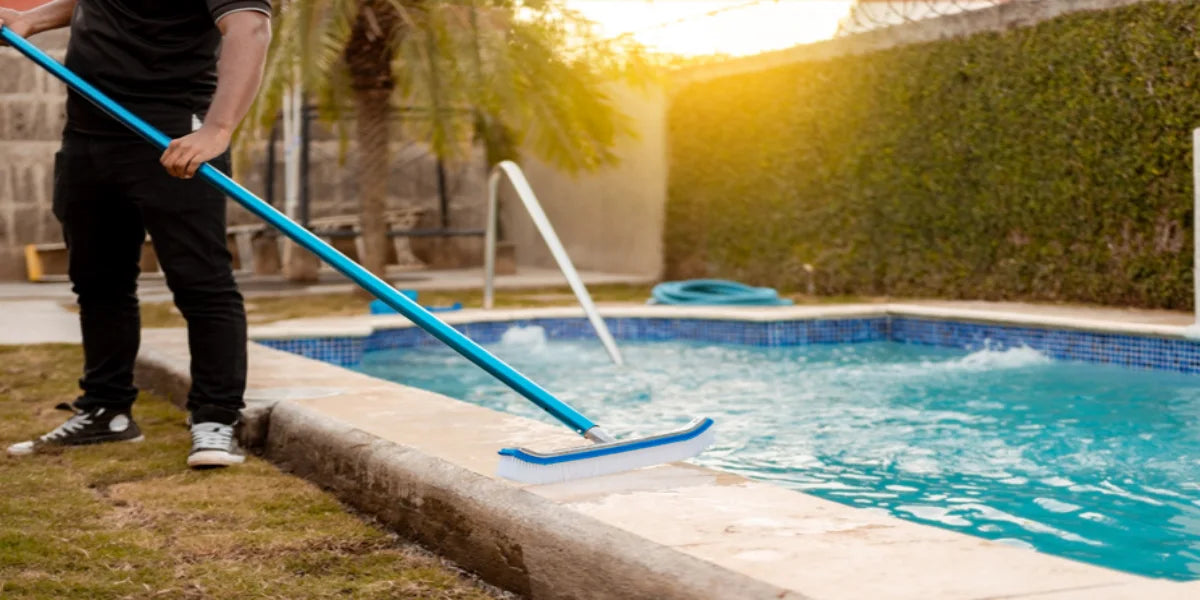A clean and well-cared swimming pool provides a haven for families to exercise, relax and have fun. Clear pool water and sparkling sunshine are every pool owner's dream.
And as the season has gradually crossed into winter, your pool starts to be used less frequently. To wait until the weather warms up and your pool is still clean, don't worry - you can take care of your pool with these simple cleaning and maintenance steps.
Tools needed to clean the pool
The right tools are what will make pool cleaning easier, and the following tools will be what you need.
- Telescopic Pole - Easily extend your reach to clean walls and floors.
- Leaf Skimmer - Collects floating debris from surfaces. Models with telescoping handles are handy.
- Pool Brush - Wipe away sticky messes from surfaces. Hard nylon bristles are best.
- Test Strips - For monitoring chlorine, pH, and other chemical levels.
- Vacuum Cleaner - Affordable manual option for quick spot cleaning.

(Pool cleaning tool)
How to clean a pool
Step 1. Remove debris
To make the process of cleaning your pool easier. You need to keep the area around the pool free from any obstructions. Check that the pool facilities are in good working condition and make sure that everything is in order. Then use a leaf skimmer to clean the debris and leaves from the pool.
Use one with a telescopic pole to clean up to the far corners. For debris that has sunk to the bottom of the pool, you will need to use a pool vacuum to get rid of this debris.

(Remove debris form swimming pool)
Step 2. Brush the walls
After a long period of use, pool walls can leave marks and are likely to harbor algae. So use a pool brush to scrub areas like walls, steps, and ladders to avoid staining and harboring bacteria.

(Brush the walls)
Step 3. Test the water
Once the pool has been cleaned of dirt, check the chemical composition of the current pool water. The optimal pH level for pool water is around 7.5. If the pH is too high, it can be lowered using an acidic substance; if it is too low, it can be raised using an alkaline substance. Maintaining the proper pH provides a comfortable swimming environment and ensures the effectiveness of other chemicals.
Alkalinity, on the other hand, is around 80 to 150 ppm. Calcium hardness is at 180 to 220 ppm. Test the water chemicals roughly once a week to make sure the pool is in tip-top condition.

(Test the pool water)
Step 4. Shock the pool
This step adds sanitizing chemicals to the pool, to eliminate contaminants and keep the water clear. The shock product is dissolved in a bucket of water based on the results of a previous water test.
Afterward, turn on the pool's filtration system and pour it around to allow it to distribute naturally throughout the pool. Finally, run the filtration system continuously to help circulate the water to achieve a cleaner result.

(Shock the pool)
How to clean pool filter
Pool filters are usually categorized as sand filters and diatomaceous earth (DE) filters. Their cleaning processes are slightly different:
- First of all, before cleaning a pool filter, you all need to turn off the pool pump to avoid safety issues.
- Afterward, set the filter valve to the "backwash" position and run it for a few minutes.
- Rinse the filter of any debris. At this point, the sand filter has been cleaned and can be set back to the filter position and the pump turned on.
- The DE filter will then need to be cleaned and the DE filter grid reinstalled and secured.
- After that, you can turn on the pump and start running the pool filter.
Different types of pool filters will be cleaned in different ways. So it's best to clean your pool filter according to its manufacturing instructions.

(Cleaning pool filter)
How to maintain a pool
After completing a deep cleaning of your pool, keep up with regular pool maintenance.
Weekly maintenance program
- Use test strips to check the chemical content of your pool water, such as pH, alkalinity, and chlorine levels.
- Clean up any debris floating on the surface of the pool once a week.
- Maintain daily water flow and run the pool pump continuously for eight hours a day. Circulating the water helps prevent algae and bacteria growth. Check the pump basket for debris to avoid clogging.
Monthly maintenance program
- Check that all equipment in the pool is functioning properly. Pumps, filters, valves, etc. Clean the filter to ensure the water is clear.
- Based on the test results of the chemical composition, decide if the pool needs to be shocked.
- If there is a ladder in the pool, check that it is not loose.
- If there is a long period when the pool will not be used, you can opt for a pool cover to keep it covered. Ensure that the interior is clean.
- Aside from a pool cover, you can also use a large party tent to provide cover for it. Apart from being a pool cover, the large party tent is also a very suitable pool shade cover, giving a nice cool shaded space for swimming in the hot summer days. It can be used in a variety of ways compared to a pool cover.
 (Quictent party tent over pool)
(Quictent party tent over pool)
Conclusion
After the above pool cleaning guide, you have mastered all the simple steps on how to clean and maintain your pool. Through deep cleaning, regular weekly and monthly maintenance, and the use of a proper shelter.
Your pool will be able to stay clear and clean for a long time. While this will take some time, it is worth it to keep your pool safe for use.






